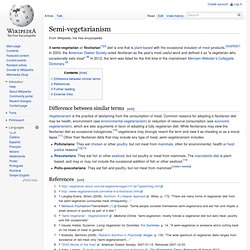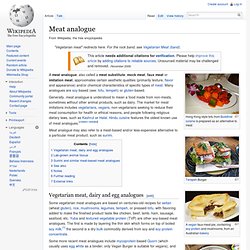

Semi-vegetarianism. A semi-vegetarian or flexitarian[1][2] diet is one that is plant-based with the occasional inclusion of meat products.[3][4][5][6][7] In 2003, the American Dialect Society voted flexitarian as the year's most useful word and defined it as "a vegetarian who occasionally eats meat".[8] In 2012, the term was listed for the first time in the mainstream Merriam-Webster's Collegiate Dictionary.[9] Difference between similar terms[edit] Vegetarianism is the practice of abstaining from the consumption of meat.

Common reasons for adopting a flexitarian diet may be health, environment (see environmental vegetarianism) or reduction of resource consumption (see economic vegetarianism), which are also arguments in favor of adopting a fully vegetarian diet. Pollotarians: They eat chicken or other poultry, but not meat from mammals, often for environmental, health or food justice reasons[12][13]Pescetarians: They eat fish or other seafood, but not poultry or meat from mammals. References[edit] Meet the 'flexitarians': Meat-eating vegetarians - Health - Fitness - Diet and Fitness.
Recession Flexitarians: Food Politics. 'Flexitarians' driving global move away from meat consumption: study - Life & Style. According to an August report from Euromonitor International, meat was one of the worst performers over the 2005 to 2010 period, with sales growing less than 14 percent over the six-year period.

Only vegetables fared slightly worse, with a growth rate of 11 percent. Meanwhile, though consumers put meat on the backburner, pulses like lentils and chickpeas gained in popularity, as did nuts and fruits which experienced a volume growth of 19 and 18 percent respectively. The global trend is a reflection of the growing movement away from meat consumption, the report pointed out. Red meat in particular has been getting a bad rap from scientists, public health authorities and governments around the world. Earlier this year, a groundbreaking study found a direct link between the consumption of red meats and processed meats and the increased risk of colorectal cancer.
And the Meatless Mondays movement has become popular among health and eco-conscious consumers. Appearance matters more than taste for meat substitutes, says study. Meat consumption has come under the spotlight in recent times, as excessive consumption of meat, especially red meat, has been linked to increased risk of various cancers and other lifestyle diseases.

In addition, high demand for animal derived proteins is adding to climate change and sustainability concerns. Some countries, such as Sweden and Germany, have incorporated environmental advice on meat eating into dietary guidelines alongside health advice. In 2007 Dr Rajendra Pachauri, chair of the United Nations’ Intergovernmental Panel on Climate Change (IPCC) and winner of the 2007 Noel Peace Prize, suggested that food manufacturers could contribute to the reduction in meat consumption by tweaking product formulations to replace some of the meat in prepared foods with alternatives. Have meat substitutes missed the boat? In the third part of the FoodNavigator focus on meat substitutes, we take a look at the market for meat and meat replacements and the reasons behind the declining growth rates for both categories.

“Growth rates for meat are declining, but this is actually appearing to be the case for meat substitutes too. Perhaps surprisingly, in markets such as Spain, Italy and the UK, there is not much difference in growth at all despite the perception that people are switching from one to the other. The figures for the substitutes are more worrying still when you factor in the much lower base rates, which usually exaggerate any growth,” says Datamonitor analyst Mark Whalley. Researchers agree on lab grown meat plans. An international group of scientists has taken a step closer to its goal of producing cultured meat by agreeing on important common positions about how to bring the research forward.

The expert panel met at a recent workshop to discuss the future of research in the area, in the process drawing up early agreed positions on some of the issues surrounding lab grown meat. The scientists noted that many of the technological components needed to successfully culture meat are now in place, including a cell source that is possible to use, several alternative processes to turn these cells into muscle cells for meat, and nutrients free of animal components which can be produced from sunlight and carbon dioxide. Meat analogue. Hong Kong style tofu from Buddhist cuisine is prepared as an alternative to meat Two slices of vegetarian bacon A meat analogue, also called a meat substitute, mock meat, faux meat or imitation meat, approximates certain aesthetic qualities (primarily texture, flavor and appearance) and/or chemical characteristics of specific types of meat.

Many analogues are soy-based (see: tofu, tempeh) or gluten-based. Generally, meat analogue is understood to mean a food made from non-meats, sometimes without other animal products, such as dairy. The market for meat imitations includes vegetarians, vegans, non-vegetarians seeking to reduce their meat consumption for health or ethical reasons, and people following religious dietary laws, such as Kashrut or Halal. Meat Analog Magic. Meat Analog Magic By AlLISON Bardic Has meatless gone mainstream?

Increased demand for all types of non-meat, high-protein alternatives creates profitable ventures for today’s food manufacturers. Walk into the freezer or refrigerated section of any grocery store and you will likely find a diverse assortment of meatless alternatives and meat analogs, designed to broaden consumer appeal and acceptance. Meat extender promises cost savings for industry. French ingredients supplier Roquette has further extended the applications for its Nutralys pea protein by teaming up with extrusion technology experts Sotexpro to develop a textured version that allows for high levels of meat substitution.

Speaking to FoodNavigator .com at FIE 2011 in Paris, Aurelie Mauray, market development manager for pea protein project at Roquette, said the powder form of its pea protein only enables a 10% replacement of meat whereas the rehydrated textured form delivers up to 30% substitution, while retaining the juiciness and texture of the meat. “Pea protein is more stable than meat in terms of prices so using less meat will guarantees cost savings for beef steak or chicken nugget processors. But the inclusion of greater amounts of a vegetable-based protein in the end product also helps boost its nutritional profile through a reduction in lipids and a better fatty acid/protein balance,” she added. Meat Analog.
Quorn. Sojasun. Cauldron. Vivera.